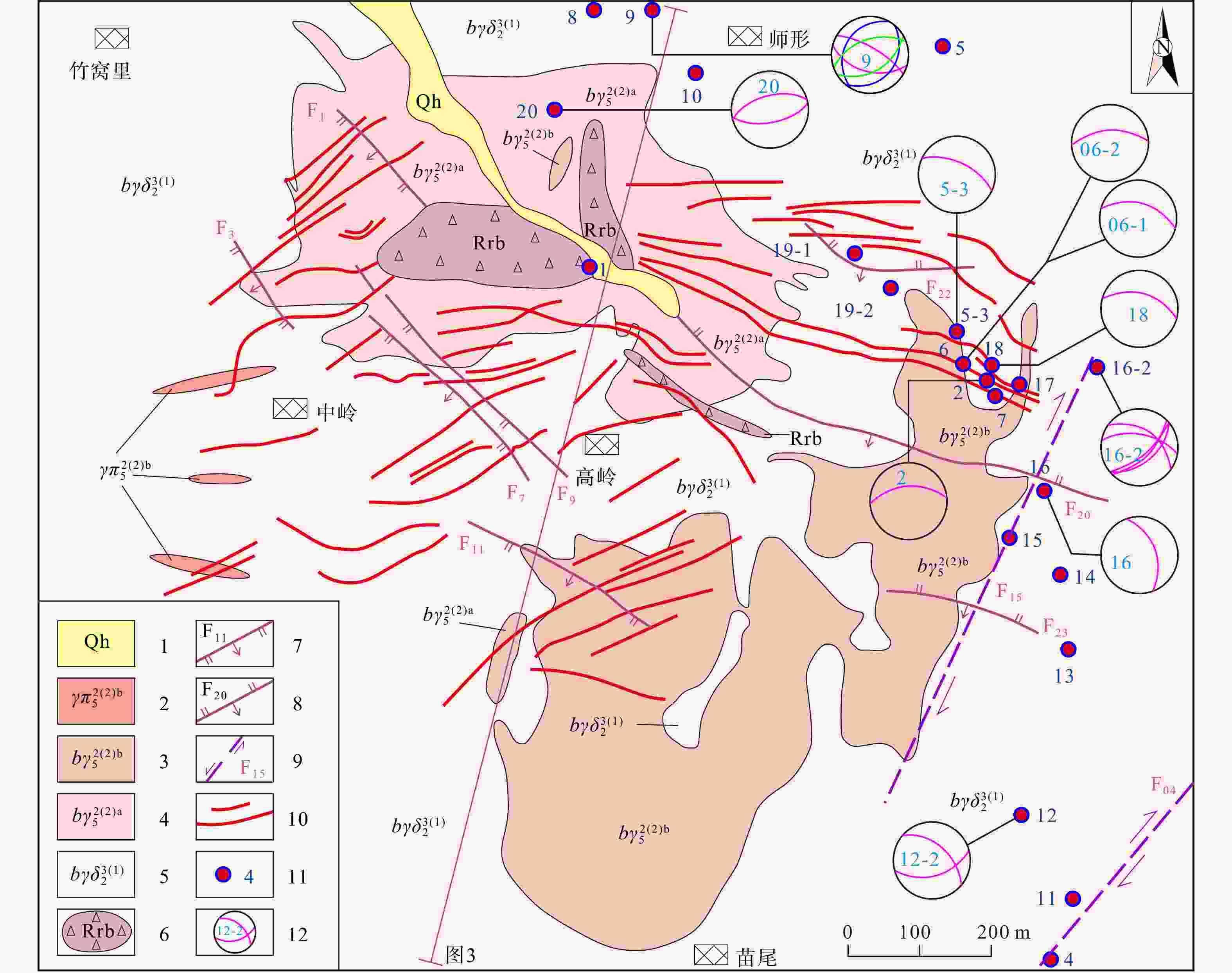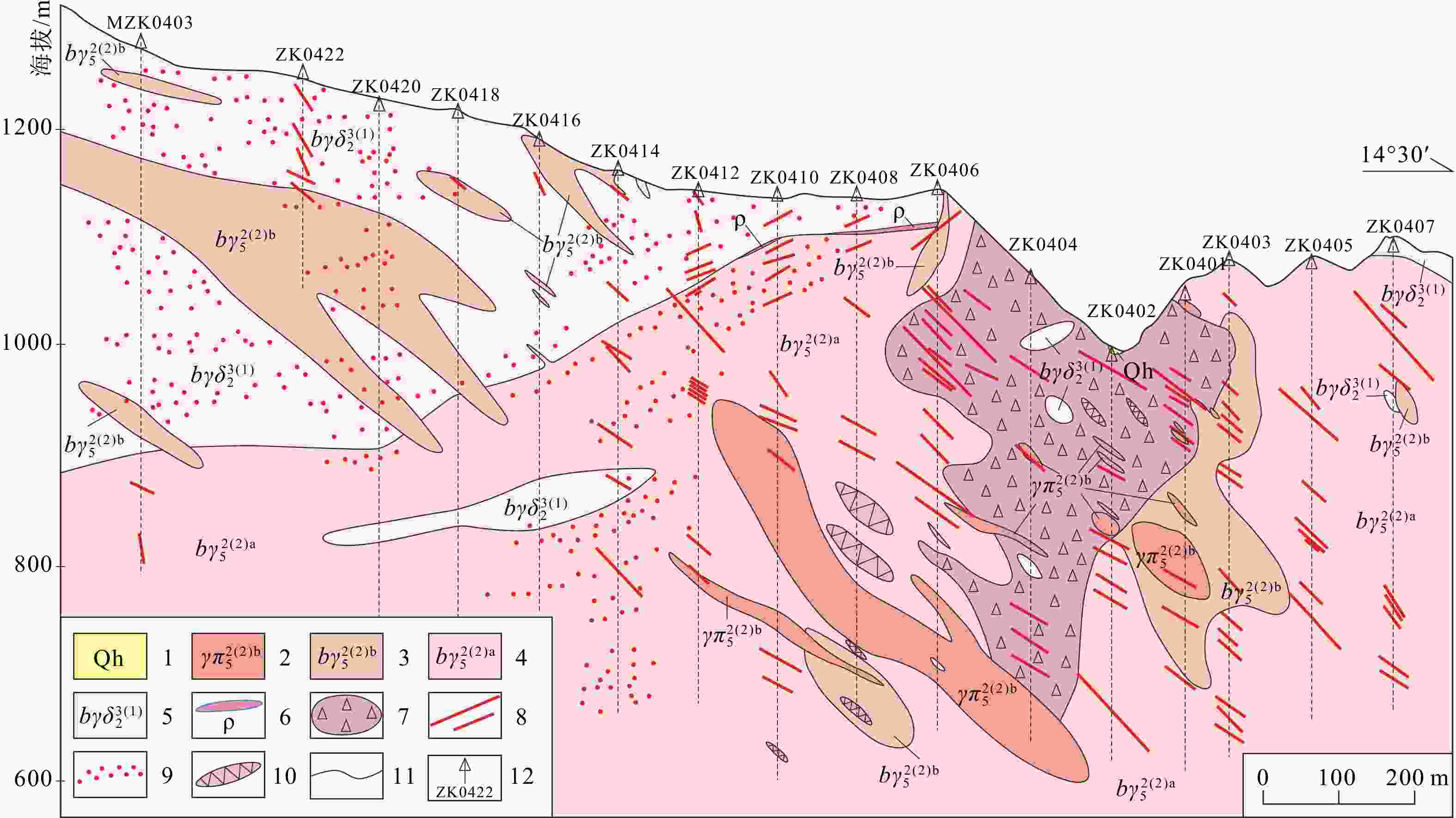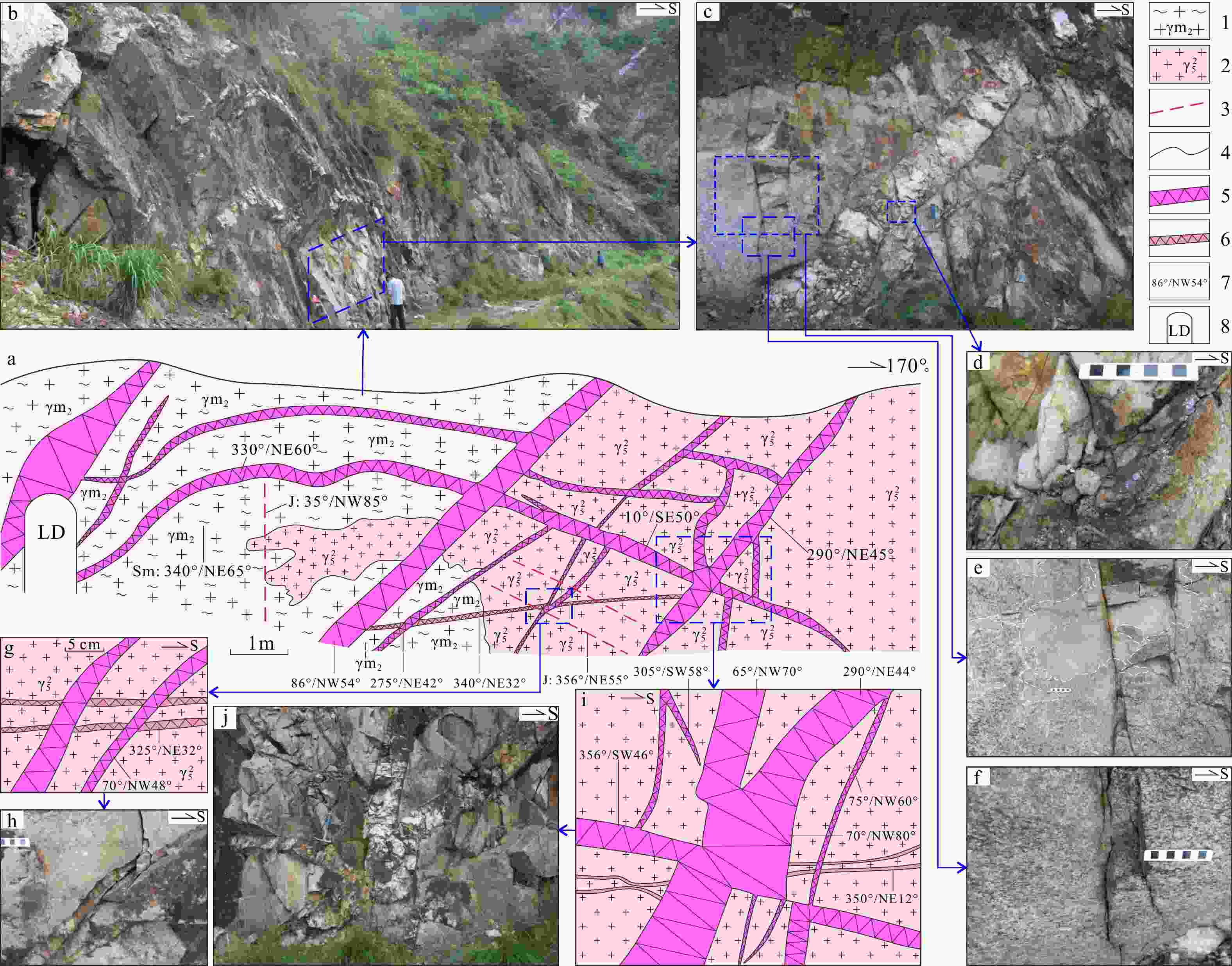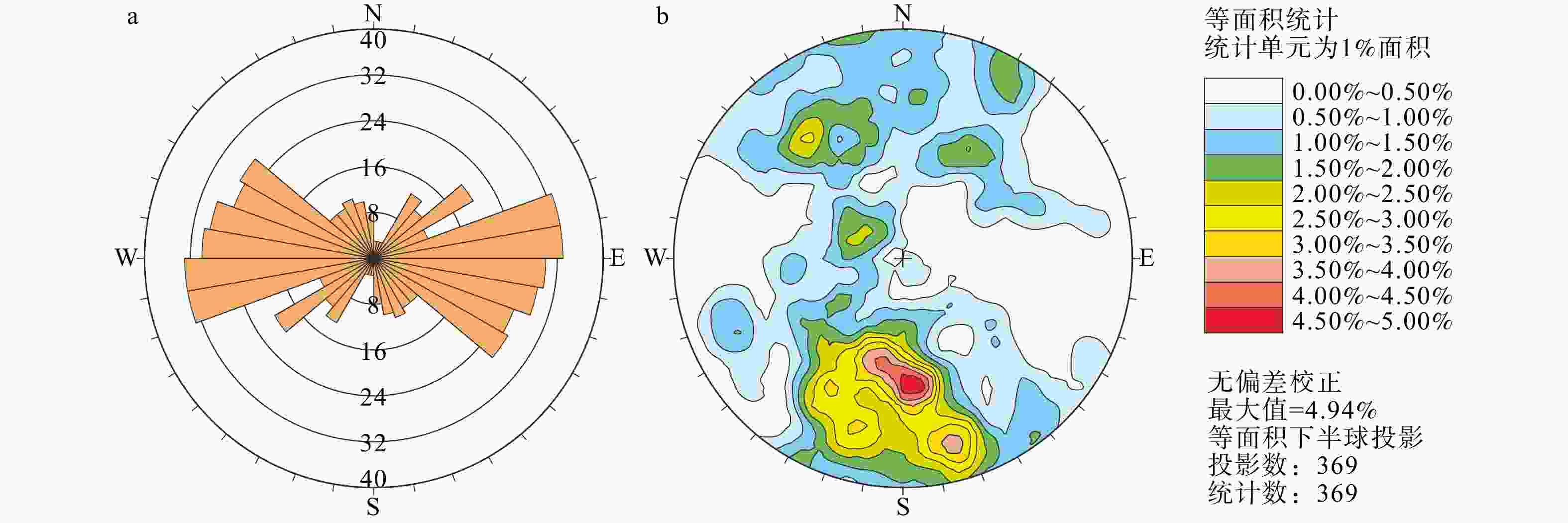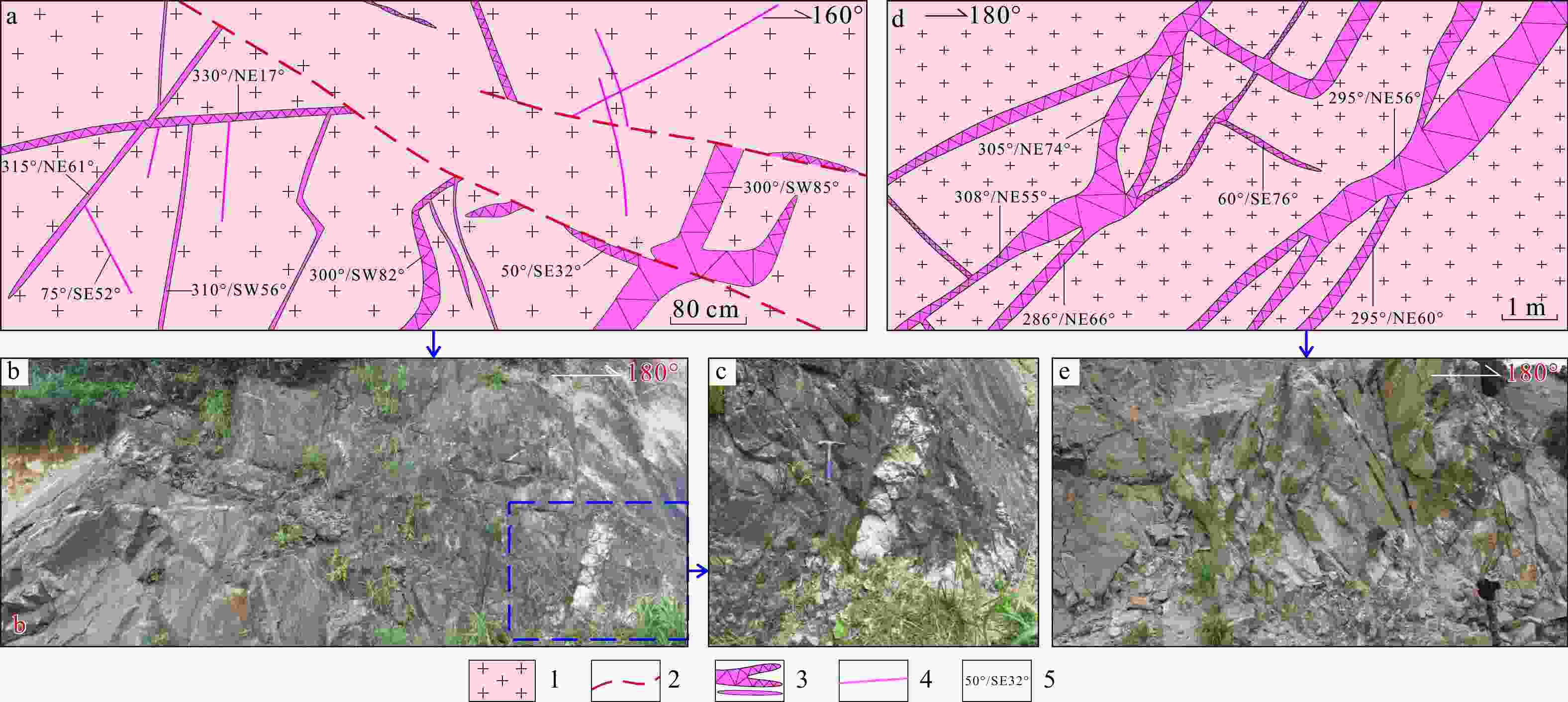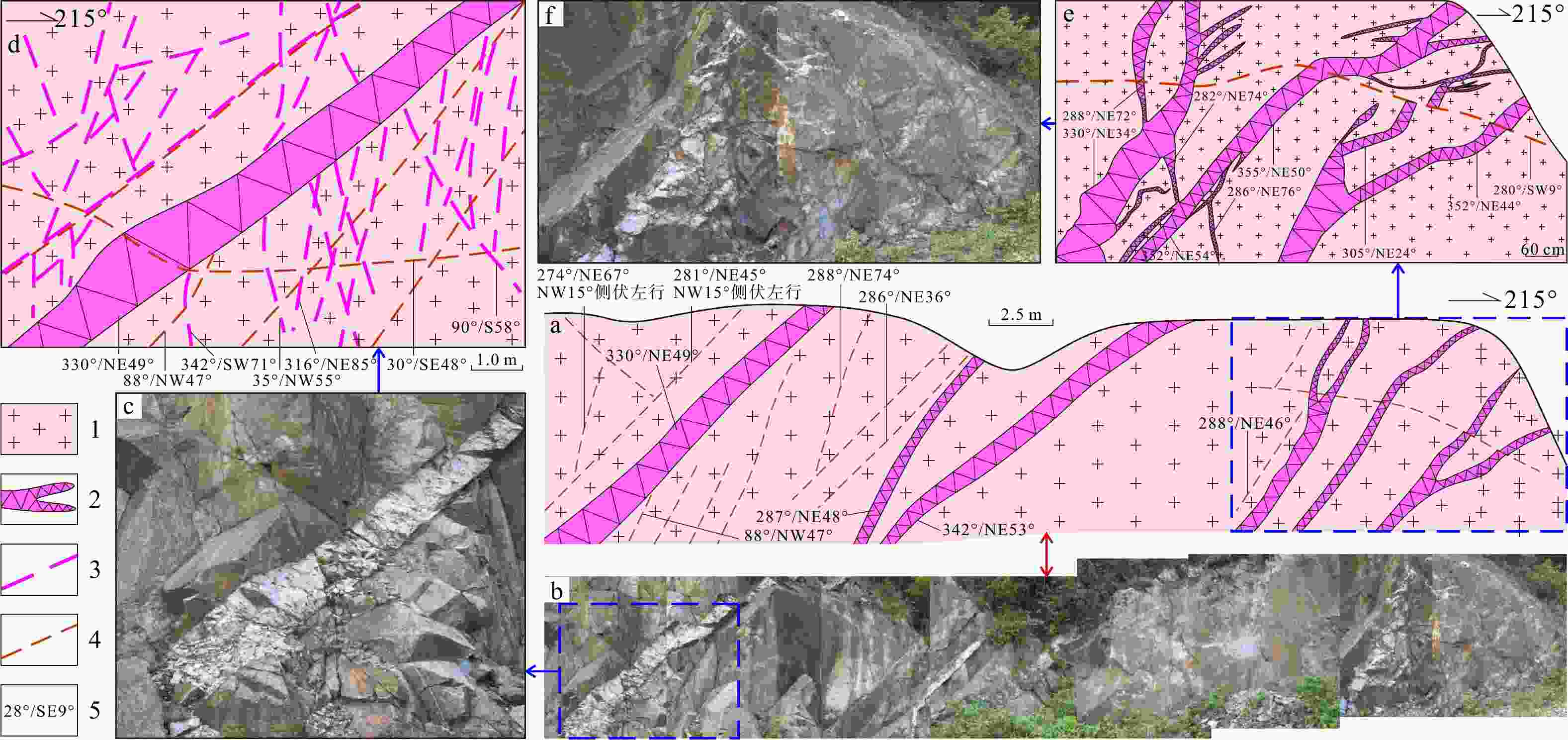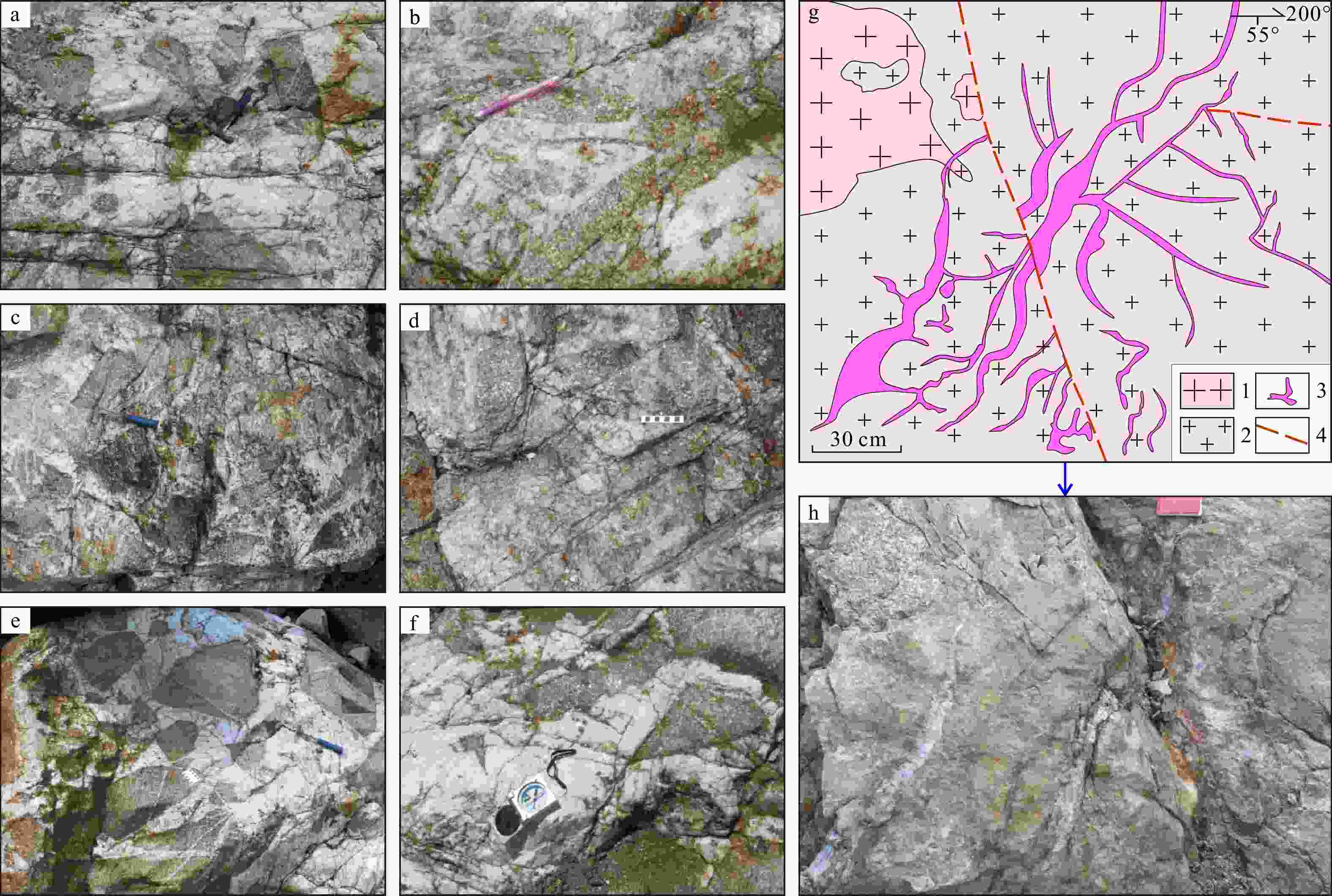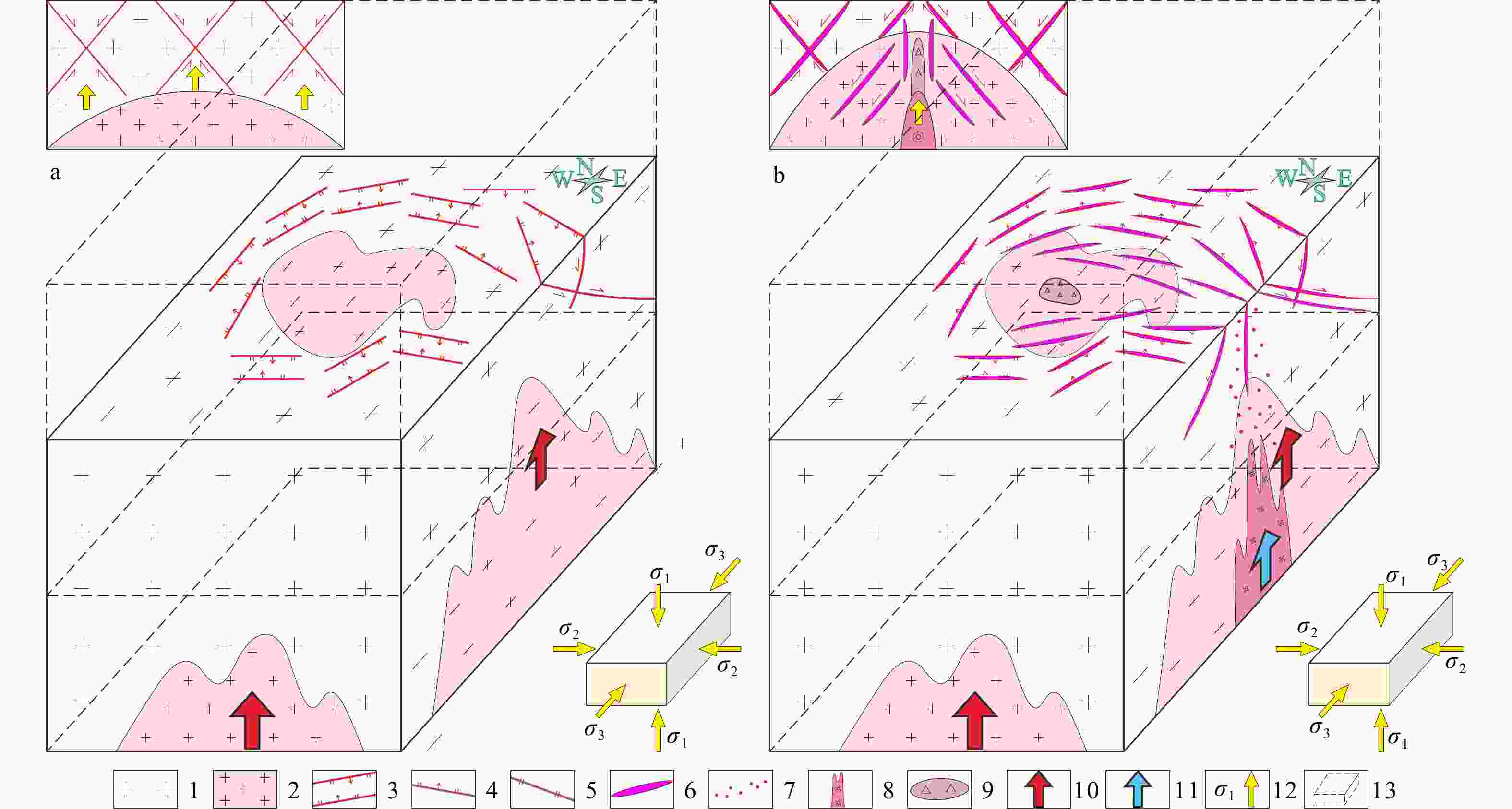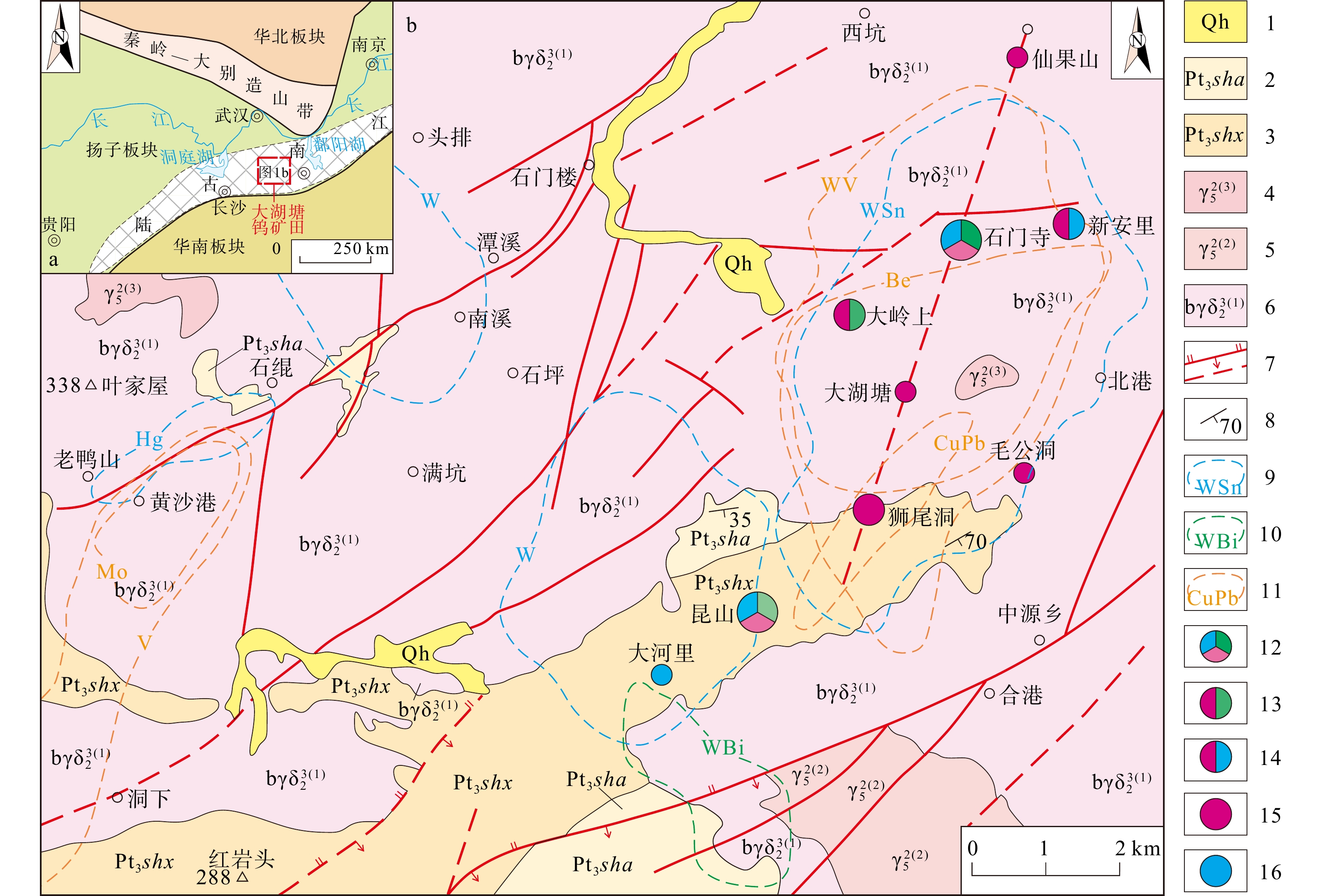Analysis of ore-controlling structures of the Shimensi tungsten deposit, Dahutang ore field, northwest Jiangxi Province
-
摘要: 大湖塘钨矿田位于赣西北九岭近东西向隆起带,是近年发现的1个世界级超大型钨多金属热液矿床聚集区,由石门寺、昆山2个大型矿床和狮尾洞、大岭上、新安里等中型矿床组成。石门寺大型钨矿床位于矿田北部,矿体发育于新元古代花岗闪长岩和燕山期花岗岩中,矿化类型有石英大脉型、细脉浸染型和热液隐爆角砾岩型,三种矿化类型围绕成矿岩体有规律产出,构造控矿作用明显。构造是控矿的最重要因素,开展控矿构造解析和构建构造控矿模型有助于重塑成矿构造的形成演化,为找矿预测提供技术支撑。文章通过野外对含矿裂隙系统的精细调查,分析了不同类型含矿裂隙的组合形式及展布特点,探讨了其形成的动力学条件,构建了构造控矿模型。研究表明:含矿构造是呈近东西向为主、北东东向和北西西向次之、多方向的小型断裂构造,整体呈现长轴为东西向的近椭圆范围内展布;从矿区外侧向中心含矿构造具有中等倾角双倾向裂隙→中等倾角单倾向外倾裂隙→陡倾角裂隙的变化趋势,中心为热液隐爆角砾岩;其中中等倾角双倾向含矿构造形成于成矿前的岩浆侵位期,最大主应力近直立,中间主应力近水平,为剖面X-型共轭剪裂隙;中等倾角单倾向外倾含矿构造和陡倾角含矿构造带形成于热液隐爆的同成矿期,最大主应力近直立,中间主应力近水平,为剖面上的单向剪裂隙和张剪性裂隙;热液隐爆中心为最大主应力近直立,中间和最小主应力均近水平且大小相近。石门寺钨矿床的控矿构造是长轴呈近东西向展布的成矿岩浆岩的岩体侵位构造和岩浆期后成矿流体的液压致裂构造;岩体侵位构造形成稍早,主要发育于成矿岩体顶部的上覆围岩(晋宁期花岗闪长岩)中,分布范围较大;岩浆期后成矿流体的液压致裂构造形成于成矿期,发育于成矿岩体上部和上覆围岩中,分布范围较窄;成矿流体的隐爆和液压致裂瞬间降低了成矿流体的压力,导致成矿物质的大量析出和有用矿物的结晶,形成钨矿床。花岗岩体侵位构造和成矿流体液压致裂构造是钨矿体的赋存空间,控制了钨矿体产出。矿区近东西向构造属于隐伏构造(基底构造),为控岩构造,控制成矿岩体长轴呈近东西向延伸,起到间接控矿作用;北西西向构造如F20断裂既不是导矿构造,也不是控矿构造,而是左行正断的破矿构造;矿田尺度的北北东向隐伏构造控制成矿岩浆岩带的展布,是高级别的控岩构造。该研究不仅可指导矿床深边部找矿,一是在矿区范围是近东西向成矿岩体东、西两端岩体倾伏部位的深部寻找隐伏矿体;二是在矿田范围有隐伏成矿岩体发育的部位寻找另一个岩体−流体成矿系统;而且该研究对中国华南地区同类型矿床的控矿构造研究具有示范作用,丰富了高温热液矿床的构造控矿理论。Abstract:
Objective The Dahutang tungsten ore field, located in the nearly EW-trending Jiuling uplift belt in northwestern Jiangxi Province, is a recently discovered area of concentrated, world-class, super-large, hydrothermal polymetallic tungsten deposits. It consists of two large tungsten deposits, namely Shimensi, Kunshan, and three medium-sized tungsten deposits, namely the Shiweidong, Dalingshang, Xin’anli deposits. The large Shimensi tungsten deposit is located in the north of the ore field, and the ore bodies are developed in Neoproterozoic granodiorite and Yanshanian granite. The mineralization is of quartz vein type, disseminated veinlet type, and hydrothermal crypto-explosive breccia type, and the three mineralization types occur regularly around the ore-forming granite mass. The ore bodies in the Shimensi tungsten deposit are obviously controlled by structure, but there is little research. Structure is the important ore-controlling factor. The analysis of ore-controlling structures and the construction of tectonic ore-controlling models can help to reconcile the formation and evolution of ore-forming structures and identify the main ore-controlling factors, which can provide technical support for prospection and prediction. Methods This study conducts a detailed field investigation of the ore-bearing fracture system, analyzes the combination of different types of ore-bearing fractures, explores the ore-forming conditions, and constructs a structural ore-controlling model. Results The research shows that the ore-bearing structure is a multi-directional small fault structure with the main trend being EW, followed by NEE and NWW; all the ore-bearing structures are present in a nearly elliptical distribution with EW-trending long axes. The ore-bearing structures change from the outside to the inside of the ore-forming granite, from those with conjugate dip at medium dip angles to those with sole outward dip at medium dip angles, and those with high dip angles; then hydrothermal crypto-explosion breccia appears in the center of the deposit. Among them, the ore-bearing conjugate shear fractures (with an X-shape in the profile) formed in the magmatic emplacement period little before mineralization in a tectonic stress field with a vertical maximum principal stress and a horizontal intermediate principal stress. The ore-bearing solely outward-dipping fractures with medium or high dip angles were formed as non-conjugate shear fractures and tension-shear fractures in the metallogenic period by hydrothermal crypto-explosion in a tectonic stress field with a vertical maximum principal stress and a horizontal intermediate principal stress. The hydrothermal crypto-explosion center formed in a tectonic stress field with a vertical maximum principal stress and similarly-sized intermediate and minimum principal stresses. Conclusion The ore-controlling structures of the Shimensi tungsten deposit are the emplacement structure of the ore-forming magmatic rock with an almost EW(NWW)-trending long axis and the hydraulic fracturing structure of the post-magmatic ore-forming fluid. The emplacement structure of the ore-forming magmatic rock, which was formed a little earlier and distributed over a larger area, developed mainly in the overlying surrounding rock (Neoproterozoic granodiorite) on the top of the ore-forming granite rock mass. The hydraulic fracturing structure of the post-magmatic ore-forming fluid was formed in the metallogenic period within a narrow distribution area in the upper and overlying surrounding rocks of the ore-forming granite rock mass. The latent explosion and hydraulic fracturing of ore-forming fluid instantly reduced the pressure of the ore-forming fluid, leading to the precipitation of ore-forming materials and the crystallization of valuable minerals, forming the tungsten deposits. The emplacement structure of the granite rock mass and the hydraulic fracturing structure of the ore-forming fluid are the sites of the tungsten ore body and control the development of tungsten ore body. The near EW(NWW)-trend of the mining area belongs to a concealed petro-controlling basement structure. This structure causes the long axis of the ore-forming granite rock mass to extend nearly EW and plays an indirect ore-controlling role. The NWW-trending faults such as F20 are neither the ore-conducting structures, nor the ore-controlling structures. They are ore-breaking, post-mineralization structures, with sinistral movement and normal shear sense. The NNE-trending concealed structure in the ore-field controls the distribution of the ore-forming magmatic rock belts and is a high-level petro-controlling structure. [ Significance ] This research can not only guide the exploration of the deeper and peripheral parts of the deposits—that is, further prospection should first search for concealed ore bodies at depth in the plunging part of the eastern and western ends of the near EW(NWW)-trending ore-forming granite rock body, and then search for other granites and fluid metallogenic systems in the area where the concealed ore-forming granite rock mass develops—but also has a demonstrative effect for studies of ore-controlling structures in similar deposits in southern China, enriching the theory of ore-controlling structures for high-temperature hydrothermal deposits. -
图 1 赣西北大湖塘钨矿田及其外围地质矿产略图(据项新葵,2012a修编)
1—全新统;2—新元古界双桥山群安乐林组千枚状变凝灰质砂岩和绢云母千枚岩;3—新元古界双桥山群修水组变凝灰质砂岩和粉砂质板岩;4—燕山晚期花岗岩;5—燕山早期花岗岩;6—晋宁晚期黑云母花岗闪长岩;7— 断层;8—产状;9—重砂扩散晕;10—土壤测量分散晕;11— 岩石测量原生晕;12—钨铜钼矿床;13—钨铜矿床;14—钨钼矿床;15—钨矿床;16—钼矿床a—大地构造图;b—矿田地质图
Figure 1. Map showing geology and mineral resource distribution of the Dahutang tungsten ore field and its vicinity, northwestern Jiangxi Province (modified after Xiang et al., 2012a)
(a) Tectonic map; ( b) Geological map of the ore field1—Holocene series; 2—Phyllite tuff sandstone and sericite phyllite of the Anlelin Formation of the Neoproterozoic Shuangqiaoshan Group; 3—Phyllite tuff sandstone and silty slate of the Xiushui Formation of the Neoproterozoic Shuangqiaoshan Group; 4—Late Yanshanian granite; 5—Early Yanshanian granite; 6—Late Jinningian biotite granodiorite; 7—Fault; 8—Orientation; 9—Heavy sand dispersion halo; 10—Measured soil dispersion halo; 11—Measured primary halo in rock; 12—Tungsten-copper-molybdenum deposit; 13—Tungsten-copper deposit; 14—Tungsten-molybdenum deposit; 15—Tungsten deposit; 16—Molybdenum deposit
图 2 大湖塘钨矿田北部石门寺钨矿床地质简图(地质底图据项新葵等,2017修编)
1—全新统;2—燕山早期第二阶段花岗斑岩;3—燕山早期第二阶段细粒黑云母花岗岩;4—燕山早期第二阶段似斑状黑云母花岗岩;5—晋宁期中粗粒黑云母花岗闪长岩;6—热液隐爆角砾岩;7—正断层;8—逆断层;9—成矿后北东向断层 ;10—石英大脉型钨矿体;11—文中地质观测点;12—含矿裂隙产状投影(赤平极射下半球投影)
Figure 2. Geological sketch of the Shimensi tungsten deposit in the northern Dahutang tungsten ore field (geological map modified after Xiang et al., 2017)
1—Holocene series; 2—Granite porphyry of the second stage in the early Yanshanian period; 3—Fine-grained biotite granite of the second stage in the early Yanshanian period; 4—Porphyritic biotite granite of the second stage in the early Yanshanian period; 5—Middle- to coarse-grained biotite granodiorite of the Jinningian period; 6—Hydrothermal crypto-explosive breccia; 7—Normal fault; 8—Reverse fault; 9—Post-mineralization NE-trending faults; 10—Quartz vein type tungsten ore body; 11—Geological observation points of this study; 12—Projection of occurrence of ore-bearing fractures (stereographic polar projection, lower hemisphere)
图 3 大湖塘钨矿田石门寺钨矿床4线地质剖面图(据项新葵等,2017修改)
1—全新统;2—燕山早期第二阶段花岗斑岩;3—燕山早期第二阶段细粒黑云母花岗岩;4—燕山早期第二阶段似斑状黑云母花岗岩;5—晋宁期中粗粒黑云母花岗闪长岩;6—似伟晶岩;7—热液隐爆角砾岩型矿体;8—石英大脉型钨矿体;9—细脉浸染型钨矿体;10—无矿石英团块、石英脉带;11—地质界线;12—钻孔及编号
Figure 3. Geological section along the No. 4 exploration line of the Shimensi tungsten deposit in the Dahutang tungsten ore field (modified after Xiang et al., 2017)
1—Holocene series; 2—Granite porphyry of the second stage in the early Yanshanian period; 3—Fine-grained biotite granite of the second stage in the early Yanshanian period; 4—Porphyritic biotite granite of the second stage in the early Yanshanian period; 5—Jinningian medium coarse-grained biotite granodiorite; 6—Pegmatite-like; 7—Hydrothermal crypto-explosive breccia orebody; 8—Quartz vein tungsten ore body; 9—Fine vein disseminated tungsten ore body; 10—Ore-free quartz cluster and quartz vein belt; 11—Geological boundaries; 12—Drill hole with number
图 4 江西大湖塘钨矿田石门寺钨矿床含矿裂隙与不含矿裂隙
a—含矿裂隙与不含矿裂隙,D06-2点;b—含矿裂隙与不含矿裂隙,D14-1点;c—含矿裂隙与不含矿裂隙,D14-2点
Figure 4. Picture showing the ore-bearing fractures and ore-free fractures in the Shimensi tungsten deposit in the Dahutang tungsten ore field, Jiangxi Province
(a) Ore-bearing fracture and ore-free fracture, point D06-2; (b) Ore-bearing fracture and ore-free fracture, point D14-1; (c) Ore-bearing fracture and ore-free fracture, point D14-2
图 5 江西大湖塘钨矿田石门寺钨矿床石英大脉和细脉型钨矿体照片及素描
1—花岗岩;2—含钨石英脉(大于5 cm);3—含钨石英细脉(0.5~5 cm);4—产状(走向/倾向倾角)a—近东西向石英大脉型钨矿体,走向延伸长,矿区中北部,D02点;b—近东西向石英大脉型钨矿体,走向延伸长,矿区中部,D19点;c—北东东向石英大脉型钨矿体,厚度大,约80 cm,矿区东南部,D03-3点;d—近东西向石英大脉型钨矿体,厚度大,约55 cm,矿区中北东部,D02点;e—近东西向石英大脉型钨矿体,厚度大,约70 cm,矿区东南部,D12-3点;f—北北西向石英大脉型钨矿体,厚度大,约70 cm,矿区东部,D16点;g—北东东向和北西西向石英细脉型钨矿体素描,矿区西北部,D20点;h—素描图g对应的照片
Figure 5. Photos and sketches showing the quartz vein and veinlet tungsten ore bodies of the Shimensi tungsten deposit, Dahutang tungsten ore field, Jiangxi Province
(a) Nearly EW-trending quartz vein tungsten ore body with a long strike extension, at point D02 of the northern part of the mining area center; (b) Nearly EW-trending quartz vein tungsten ore body with a long strike extension, at point D19 of the mining area center; (c) NEE-trending quartz vein tungsten ore body with a large thickness of about 80 cm, at point D03-3 of the southeastern mining area; (d) Nearly EW-trending quartz vein tungsten ore body with a thickness of about 55 cm, at point D02 of the northern part of the mining area center; (e) Nearly EW-trending quartz vein tungsten ore body with a large thickness, about 70 cm, at point D12-3 of the southeastern mining area; (f) NNW-trending quartz vein tungsten ore body with a large thickness of about 70 cm, at point D16 of the eastern mining area; (g) Sketch of NE- and NW-trending quartz veinlet tungsten ore bodies, point D20 of the northwestern mining area; (h) Photo corresponding to sketch g1—Granite; 2—W-bearing quartz vein (thicker than 5 cm); 3—W-bearing quartz veinlets (0.5~5 cm); 4—Orientation (trend / dip angle)
图 6 大湖塘钨矿含钨石英脉野外照片及素描图(D02点)
1—片麻状花岗岩;2—中细粒花岗岩;3—无矿节理裂隙;4—地质界线;5—含钨石英脉;6—早期无矿石英细脉;7—产状;8—老硐a—含钨石英脉素描,矿区中北部,D02点;b—剖面a对应的照片;c—图片b中部偏北侧局部放大,示走向近东西向中等倾角北倾的含钨石英大脉;d—图片c的局部放大,示含钨石英脉边部发育辉钼矿; e—图片c的局部放大,示含钨石英脉的围岩燕山期细粒花岗岩侵入在晋宁期片麻状粗粒花岗闪长岩中;f—图片c的局部放大,示含钨石英脉围岩晋宁期片麻状粗粒花岗闪长岩;g—剖面a中部局部放大素描,示北东东向中等倾角北倾含钨石英脉,穿切早期无矿石英细脉;h—剖面g对应的照片; i—剖面a的南部局部放大素描,示多个产状含钨石英脉同时贯入结晶,穿切早期无矿石英细脉;j—剖面i对应的照片
Figure 6. Sketches and pictures showing the distribution of ore-bearing fractures and tungsten-bearing quartz veins in the Shimensi tungsten deposit, Dahutang tungsten ore field, Jiangxi Province (point D02)
(a) Sketch of tungsten-bearing quartz veins, north-central mining area, point D02; (b) Photos corresponding to section a; (c) The local enlargement of the north-central part of picture b, shows a tungsten-bearing quartz vein with a nearly east-west strike direction and a moderately northward dip; (d) The local enlargement of picture Cc shows that molybdenite is developed at the edge of the tungsten-bearing quartz vein; (e) The partial enlargement of picture c shows the intrusion of a fine-grained Yanshanian granite into a coarse-grained gneissic Jinningian granodiorite; both are surrounding rocks of the tungsten-bearing quartz vein ore body; (f) The partial enlargement of picture c shows coarse-grained gneissic Jinningian granodiorite as rock surrounding a tungsten-bearing vein ore body; (g) The enlarged sketch of the middle part of section a shows a tungsten-bearing quartz vein with moderate NE-ward dip cutting an early-stage, ore-free quartz vein; (h) Photos corresponding to section g; (i) The enlarged sketch of the southern part of section a shows the penetration of multiple tungsten-bearing quartz veins into fractures and crystalline at the same time, thereby cutting early-stage, ore-free quartz veins; (j) Photos corresponding to section i1—Gneissic granite; 2—Medium-fine grained granite; 3—Ore-free joints and fissures; 4—Geological boundary; 5—W-bearing quartz vein; 6—Early ore-free quartz veinlet; 7—Orientation; 8—Ancient mining tunnel
图 7 大湖塘钨矿田石门寺钨矿床含矿裂隙产状投影图
a—含矿裂隙走向玫瑰图;b—含矿裂隙极点的极射赤平投影等值线图(下半球投影)
Figure 7. Projection of the strike of ore-bearing fractures in the Shimensi tungsten deposit of the Dahutang tungsten ore field
(a) Rose diagram showing the strike of ore-bearing fractures; (b) Contoured polar stereographic projection of the poles of ore-bearing fractures (lower hemisphere projection)
图 8 大湖塘钨矿含钨石英脉野外照片及素描图(D09号D16-2点)
1—晋宁期花岗岩;2—含钨石英脉;3—早期无矿石英脉;4—成矿后断裂a—中偏缓倾角双倾向含钨石英细脉,矿区北部,D09点;b—剖面a对应的照片;c—剖面a的局部放大,示不同倾向含钨石英细脉同时贯入结晶;d—剖面a的局部放大,示不同倾向的含钨石英细脉同时贯入结晶;e—照片b的局部放大,示不同倾向含钨石英细脉同时贯入结晶;f—剖面a和照片e的局部放大,示含矿裂隙有小位移,但含钨石英脉为同时贯入结晶;g—中偏缓倾角双倾向含钨石英细脉,矿区东部,D16-2点;h—剖面g对应的照片
Figure 8. Sketches and pictures showing the distribution of ore-bearing fractures and W-bearing quartz veins in the Shimensi tungsten deposit, Dahutang tungsten ore field, Jiangxi Province (points D09 and D16-2)
(a) Tungsten-bearing quartz veinlet with moderate-gentle dip angle toward either the south or north, northern part of the mining area, point D09; (b) Photos corresponding to section a; (c) The local enlargement of section a shows the penetration of conjugate tungsten-bearing quartz veinlets into crystalline; (d) The local enlargement of section a shows the penetration of tungsten-bearing quartz veinlets with different orientations penetrate into crystalline at the same time; (e) The local enlargement of photo b shows the penetration of tungsten-bearing quartz veinlets with different trends into crystalline at the same time; (f) The local enlargement of section a and photo e show a small displacement of the ore-bearing fracture, but both segments of the tungsten-bearing quartz vein intruded and crystallized at the same time; (g) Tungsten-bearing quartz vein with moderate-gentle dip angle and conjugate dip, eastern part of the mining area, D16-2; (h) Photos corresponding to section g 1—Jinningian granite; 2—W-bearing quartz vein; 3—Early ore-free quartz vein; 4—Fracture post-dating mineralization
图 9 大湖塘钨矿含钨石英脉野外照片及素描图(D12-2点和D05-3点)
1—晋宁期花岗岩;2—晚期裂隙/断裂;3—含钨石英脉(4~40 cm);4—含钨石英细脉(1~3 cm); 5—产状a—中等倾角南倾中细含钨石英脉,矿区东南部,D12-2点;b—剖面a对应的照片;c—照片b的局部放大;d—中等倾角北倾粗大含钨石英脉,矿区中北部,D5-3点;e—剖面d对应的照片,含钨石英脉最宽达80 cm
Figure 9. Sketches and pictures showing the distribution of ore-bearing fractures and W-bearing quartz veins in the Shimensi tungsten deposit of the Dahutang tungsten ore field, Jiangxi Province (points D12-2 and D05-3)
(a) Medium-thin tungsten-bearing quartz vein with moderate southward dip in the southeast of the mining area, at point D12-2; (b) Photos corresponding to section a; (c) Local enlargement of photo b; (d) Medium-thick tungsten-bearing quartz vein with moderate northward dip in the north-central part of the mining area, point D5-3; (e) Photo corresponding to section d, the width of the tungsten-bearing quartz vein is up to 80 cm. 1—Jinningian granite; 2—Fracture post-dating mineralization; 3—W-bearing quartz vein; 4—W-bearing quartz veinlet; 5—Orientation
图 10 大湖塘钨矿含钨石英脉野外照片及素描图(D16点)
1—晋宁期花岗岩;2—含钨石英大脉(大于5 cm);3—含钨石英细脉(1~5 cm);4—晚期断裂;5—产状a—中等倾角北倾粗大含钨石英脉,矿区东北部,D16点;b—剖面a对应的照片;c—照片b的局部放大,含钨石英脉最宽达80 cm;d—照片c对应的剖面;e—剖面a的局部放大剖面;f—剖面e对应的照片
Figure 10. Sketches and pictures showing the distribution of ore-bearing fractures and W-bearing quartz veins in the Shimensi tungsten deposit of the Dahutang tungsten ore field, Jiangxi Province (point D16)
(a) Tungsten-bearing quartz vein with moderate northward dip and a large thickness, in the northeast of the mining area, point D16; (b) Photos corresponding to section a; (c) The local enlargement of photo b shows that the width of the tungsten-bearing quartz vein is up to 80 cm; (d) Section corresponding to photo c; (e) Local enlargement of section a; (f) Photo corresponding to section e1—Jinningian granite; 2—W-bearing quartz vein; 3—W-bearing quartz veinlet; 4—Fracture post-dating mineralization; 5—Orientation
图 11 大湖塘钨矿含钨石英脉野外照片及素描图(D18点、D06点和D6-1点)
1—晋宁期花岗岩;2—晚期断裂,3—含钨石英脉;4—黄铜矿团块;5—辉钼矿团块;6—产状a—中等倾角北倾中粗含钨石英脉,矿区中北部,D18点;b—剖面a对应的照片;c—中等倾角北倾中粗含钨石英脉,矿区中北部,D06-1点;d—剖面c对应的照片;e—照片d的局部放大,含钨钼石英脉最宽达80cm;f—照片e的局部放大,石英脉中的辉钼矿;g—照片e的局部放大,石英脉中的辉钼矿;h—图片c的局部放大照片,含钨钼石英脉中辉钼矿被淋漓后残留的片状空洞;i—中等倾角北倾中粗含钨石英脉,矿区中北部,D06-2点;j—剖面i对应的照片
Figure 11. Sketches and pictures showing the distribution of ore-bearing fractures and W-bearing quartz veins in the Shimensi tungsten deposit of the Dahutang tungsten ore field, Jiangxi Province (points D18, D06, and D6-1)
(a) Tungsten-bearing quartz vein with medium-large thickness and medium northward dip, from the north-central part of the mining area, point D18; (b) Photos corresponding to section a; (c) Tungsten-bearing quartz vein with medium-large thickness and medium northward dip, from the north-central part of the mining area, point D06-1; (d) Photos corresponding to section c; (e) The local enlargement of photo d shows that the width of the ore-bearing quartz vein containing tungsten and molybdenum is up to 80 cm; (f) Local enlargement of photo e, molybdenite in the ore-bearing quartz vein; (g) Partial enlargement of photo e, molybdenite in a tungsten-bearing quartz vein; (h) The partial enlargement part of picture c show the flaky cavities left by molybdenite leaching in a W-Mo-bearing quartz vein; (i) Tungsten-bearing quartz vein with medium northward dip and medium-large thickness, north-central mining area, point D06-2; (j) Photos corresponding to section i 1—Jinningian granite; 2—Fracture post-dating mineralization; 3—W-bearing quartz vein; 4—Chalcopyrite cluster; 5—Molybdenite cluster; 6—Orientation
图 12 大湖塘钨矿含钨石英脉野外照片及素描图(D19点)
1—双桥山群变质岩残留体;2—晋宁期花岗岩;3—燕山期花岗岩,4—含钨石英脉(大于5 cm);5—含钨石英细脉(1~4 cm);6—成矿后小断层或裂隙;7—产状a~c—露天采场D19点相连剖面素描,长190.8 m(a—北西段;b—中段;c—南东段);d—剖面北西段的北西部分对应照片,显示中等倾角含钨石英脉;e—为d的局部放大;f—剖面北西段中南部分对应照片,显示两期花岗岩;g—图片f的局部放大,显示燕山期花岗岩;h—图片f的局部放大,显示燕山期花岗岩与晋宁期花岗岩的侵入接触关系;i—图片f的局部放大,显示中等偏陡倾角含钨石英脉;j—图片i的局部放大,显示中等偏陡倾角含钨石英脉;k—剖面北西段的南东部分对应照片,显示产状陡立的含钨石英细脉;l—剖面中段的北西部分对应的照片,显示产状陡立的含钨石英细脉;m—剖面中段的南部局部放大素描,显示多走向的陡立含钨石英脉;n—剖面南段北部局部放大素描,显示不规则树枝状含钨石英细脉;o—素描图n对应的照片;p—剖面南段中偏北部分局部放大素描,显示中等偏陡的含钨石英脉;q—剖面南段的南部局部素描,显示中等偏缓倾角的含钨石英脉;r—素描图q对应的照片
Figure 12. Sketches and pictures showing the distribution of ore-bearing fractures and W-bearing quartz veins in the Shimensi tungsten deposit of the Dahutang tungsten ore field, Jiangxi Province (point D19)
(a)—(c) Sketch of a continuous, 190.8 m long section of the open pit at point D19 (a. northwest section; b. central section; c. southeast section); (d) The photo of the northwestern part of the northwest section in a shows a tungsten-bearing quartz vein with a medium dip angle; (e) Local enlargement of d; (f) Photos of the south-central part of the northwestern section, showing two periods of granites; (g) The partial enlargement of picture f shows a Yanshanian granite; (h) The partial enlargement of picture f shows the intrusive contact between a Yanshanian granite and a Jinningian granite; (i) The local enlargement of picture f shows a tungsten-bearing quartz vein with moderately steep dip angle; (j) The local enlargement of picture i shows a tungsten-bearing quartz vein with moderately steep dip angle; (k) The photograph of the southeastern part of the northwest section shows steep tungsten-bearing quartz veinlets; (l) The photograph of the northwestern part of the central section shows steep tungsten-bearing quartz veinlets; (m) Sketched enlargement of the southern part in the central section, showing multi-directional steep tungsten-bearing quartz veins; (n) Sketched enlargement of the northern part of the southern section, showing irregular dendritic tungsten-bearing quartz veinlets; (o) Photo corresponding to sketch n; (p) Sketched enlargement of the north-central part of the south section, showing a moderately steep tungsten-bearing quartz vein; (q) Sketch of the southern part of the southern section, showing a tungsten-bearing quartz vein with moderate and gentle dip angle; (r) Photo corresponding to sketch q 1—Remnants of metamorphic rocks of the Shuangqiaoshan Group; 2—Jinningian granite; 3—Yanshanian granite; 4—Tungsten-bearing quartz vein; 5—Tungsten-bearing quartz veinlet; 6—Small faults or fractures after mineralization; 7—Orientation
图 13 石门寺钨矿床不同产状含钨石英脉具有同期充填结晶的特点
a—北西西向北缓倾与北东向近直立含钨石英脉同期充填结晶,矿区中部,D01点,平面照片;b—东西向与北东向近直立含钨石英脉同期充填结晶,矿区中部,D01点,平面照片;c—北西向和北东向粗大含钨石英脉与东西向和南北向含钨石英细脉同期充填结晶,矿区中部,D01点,平面照片;d—北北东向不同倾角含钨石英脉同期充填结晶,矿区东部,D03点,剖面照片;e—北北西向缓倾与北东东向陡倾含钨石英脉同期充填结晶,矿区北部,D05点,剖面照片;f—北东东向南倾与北倾含钨石英细脉同期充填结晶,矿区北部,D09点,剖面照片;g—北西西向北倾与北西向南倾含钨石英细脉同期充填结晶,矿区东部,D14点,剖面照片;h—北北西向东倾与北东东向北倾含钨石英细脉同期充填结晶,矿区东部,D14点,剖面照片;i—近东西向南倾与北倾含钨石英脉同期充填结晶,矿区中部,D19点,剖面照片; j—北西西向北倾含钨石英脉穿切早期北东东向陡倾无矿石英细脉,D05点,平面照片;k—含钨石英脉(70°/NW48°)切割早期无矿细石英脉(325°°/NE32°),D02点;l—北西西向陡倾含钨石英脉穿切北东东向早期无矿石英细脉,D19点
Figure 13. Photos showing the intrusion-crystallization characteristics of different occurrences of W-bearing quartz veins in the Shimensi tungsten deposit, Dahutang tungsten ore field, Jiangxi Province
(a) Simultaneous intrusion and crystallization of WNW-trending gently N-dipping and NE-trending nearly vertical tungsten-bearing quartz veins, central part of the mine, point D01, plan photo; (b) EW-trending and NE-trending vertical tungsten-bearing quartz veins intruded and crystallized at the same time in the center of the mining area, point D01, plane photo; (c) NW-trending and NE-trending thick tungsten-bearing quartz veins and EW-trending and SN-trending tungsten-bearing quartz veinlets intruded and crystallized at the same time, center of the mining area, point D01, plane photo; (d) NNE-trending tungsten-bearing quartz veins with different dip angles intruded and crystallized at the same time, eastern part of the mining area, point D03, profile photo; (e) WNW-trending tungsten-bearing quartz veins with low dip angle and ENE-trending vertical tungsten-bearing quartz veins filled and crystallized at the same time, northern part of the mining area, D05 point, profile photo; (f) ENE-trending tungsten-bearing quartz veinlets dipping to south and these dipping to north fill and crystallize at same time in the north of the mining area, point D09, profile photo; (g) WNW-trending, N-dipping tungsten-bearing quartz veinlets and NE-trending, S-dipping tungsten-bearing quartz veinlets intruded and crystallized at the same time in the east of the mining area, point D14, profile photo; (h) NNW-striking, E-inclining and NEE-striking, N-inclining tungsten-bearing quartz veinlets intruded and crystallized at the same time, eastern part of the mining area, point D14, profile photo; (i) Contemporaneous intrusion and crystallization of tungsten-bearing quartz veins with nearly E–W strike and S-dip or N-dip, central mining area, point D19, profile photo; (j) WNW-striking tungsten-bearing quartz veins intersect early NE-striking steeply dipping ore-free quartz veinlets, point D05, plane photo; (k) A tungsten-bearing quartz vein (70°/NW48°) cuts an early ore-free quartz veinlet (325°/NE32°) at point D02; (l) WNW-trending steeply dipping tungsten-bearing quartz vein cuts a ENE-trending early ore-free quartz vein, point D19.
图 14 大湖塘钨矿田石门寺钨矿床含钨石英脉的隐爆特征(D01点和D19-4点)
1—晋宁期花岗岩;2—燕山期花岗岩;3—含钨石英脉;4—晚期小断层a—热液隐爆角砾岩,角砾为燕山期花岗岩,含钨石英质为胶结物,花岗岩角砾总体呈棱角状,但尖角被熔蚀、具有近似可拼合特点,矿区中部,D01点,近水平面照片;b—含钨石英脉呈多方向、不规则状发育,倾角较陡,脉间花岗岩块体具有棱角状、近似可拼合特点,矿区中部,D01点,近水平面照片;c—含钨石英胶结物较多、不规则状发育,花岗岩角砾熔蚀较强,棱角不太明显,矿区中部,D01点,近水平面照片;d—含钨石英质呈多方向、不规则状发育,脉间花岗岩块体棱角被熔蚀,矿区中部,D01点,近水平面照片;e—热液隐爆角砾岩,角砾为燕山期花岗岩,含钨石英质为胶结物,花岗岩角砾总体呈棱角状,但尖角被熔蚀、具有近似可拼合特点,矿区中部,D01点,近水平面照片;f—热液隐爆角砾岩,角砾为燕山期花岗岩,含钨石英质为胶结物,花岗岩角砾总体呈棱角状,但尖角被熔蚀、具有近似可拼合特点,矿区中部,D01点,近水平面照片;g—素描图,示含钨石英脉呈蟹腿状或菊花状形态,矿区中部,D19-4点;h—素描图g对应的照片
Figure 14. Sketch and pictures showing the crypto-explosion characteristics of tungsten-bearing quartz veins in the Shimensi tungsten deposit, Dahutang tungsten ore field, Jiangxi Province (points D01 and D19-4)
(a) Hydrothermal crypto-explosion breccia, the breccia is Yanshanian granite which is cemented by tungsten-bearing quartz; the granite fragments are generally angular, but the sharp corners have been and corroded, which has characteristics of approximate splicing, photo of a nearly horizontal plane taken at point D01 of the central part of the mining area; (b) Tungsten-bearing quartz veins developed in multiple directions and irregularly, with a steep dip angle, and the granite blocks between veins are angular and approximately splitable, photo of a nearly horizontal plane taken at point D01 of the central mining area; (c) There are many tungsten-bearing quartz cements with irregular development, granite breccia is eroded strongly, and the edges and corners are not obvious, photo of a nearly horizontal plane taken at point D01 of the central part of the mining area. (d) Tungsten-bearing quartz develops in multi-directional and irregularly, and the edges and corners of the granite blocks between the veins were corroded, photo of a nearly horizontal plane taken at point D01 of the central part of the mining area. (e)—(f) Hydrothermal crypto-explosive breccia, the breccia is Yanshanian granite cemented by tungsten-bearing quartz, and the granite breccia is generally angular, but its sharp corners were corroded, similar to splicing characteristics; central part of the mining area, point D01, near-horizontal photos; (g) Sketch showing that the tungsten-bearing quartz vein is crab-leg-like or chrysanthemum-shaped, taken at D19-4 in the center of the mining area; (h) Photo corresponding to sketch g 1—Jinningian granite; 2—Yanshanian granite; 3—Tungsten-bearing quartz vein; 4—Late small fault
图 15 石门寺钨矿床2类3型含钨裂隙形成应力场条件
σ1—最大主应力;σ2—中间主应力;σ3—最小主应力 a—第I类含矿裂隙形成的应力场条件; b—第II-1型含矿裂隙形成的应力场条件; c—II-2型含矿裂隙形成的应力场条件
Figure 15. Stress field of two types (three kinds) of tungsten-bearing fractures in the Shimensi tungsten deposit
(a) Stress field for the formation of kind I ore-bearing fractures; (b) Stress field for the formation of type II-1 ore-bearing fractures; (c) Stress field for the formation of type II-2 ore-bearing fracturesσ1—the maximum principal stress;σ2—the intermediate principal stress;σ3—the minimum principal stress
图 16 赣西北大湖塘矿田石门寺钨矿床控矿构造形成演化模式
1—晋宁期花岗闪长岩;2—燕山期成矿花岗岩;3—成矿期剖面共轭断裂;4—成矿期单倾向断裂;5—成矿期陡倾角张扭性断裂;6—石英大脉型钨矿体;7—细脉浸染型钨矿体;8—岩浆期后成矿流体;9—热液隐爆角砾岩;10—岩浆侵位方向;11—成矿流体运移方向;12—主应力及方向;13—浅部块体;σ1—最大主应力;σ2—中间主应力;σ3—最小主应力a—岩体侵位早期含矿构造形成期;b—晚期含矿构造形成与成矿期
Figure 16. Evolution model of the ore-controlling structures of the Simensi tungsten deposit, Dahutang tungsten ore field, northwestern Jiangxi Province
(a) Formation period of the early ore-bearing structures with emplacement of the rock mass; (b) Formation of the late ore-bearing structures and metallogenic period1—Jinningian granodiorite; 2—Yanshanian metallogenic granite; 3—Conjugate faults in the profile of the metallogenic period; 4—Single-dip fault of the metallogenic period; 5—Tension-torsion fault with steep dip angle of the metallogenic period; 6—Quartz vein type tungsten ore body; 7—Disseminated vein tungsten ore body; 8—Post-magmatic ore-forming fluid; 9—Hydrothermal blasting breccia; 10—Magma emplacement direction; 11—Migration direction of ore-forming fluid; 12—Principal stress with direction; 13—Shallow block; σ1—the maximum principal stress; σ2—the intermediate principal stress; σ3—the minimum principal stress
-
[1] CHEN B L, GAO Y, SHEN J H, et al., 2021. Study on the ore-bearing fracture system of the Zoujiashan uranium deposit, Jiangxi, SE China[J]. Acta Geologica Sinica, 95(5): 1523-1544. (in Chinese with English abstract [2] CHEN B L, 2024. Characteristics of hydraulic ore-bearing structure: A case study of hydrothermal tungsten and uranium deposits in South China[J]. Journal of Geomechanics, 30(1): 15-37. (in Chinese with English abstract [3] CHEN C F, GAO J F, ZHANG Q Q, et al., 2021. Evolution of ore-forming fluids in Shimensi tungsten polymetallic deposit of northern Jiangxi: constraints from in situ trace element analysis of scheelite[J]. Mineral Deposits, 40(2): 293-310. (in Chinese with English abstract [4] CHEN M S, XIANG X K, ZHAN G L, et al., 2020. Geochronology, geochemical characteristics of the post-mineralization late Yanshanian granite porphyry and its constraints for the terminal of the metallogeny in the No. 1 Ore Beltt of the Dahutang district of the Dahutang district[J]. Journal of East China University of Technology (Natural Science), 43(5): 401-416. (in Chinese with English abstract [5] CHU P L, DUAN Z, LIAO S B, et al., 2019. Petrogenesis and tectonic significances of late Mesozoic granitoids in the Dahutang area, Jiangxi province: constraints from zircon U-Pb Dating, mineral-chemistry, geochemistry and Hf isotope[J]. Acta Geologica Sinica, 93(7): 1687-1707. (in Chinese with English abstract [6] DAN X H, JIANG S Y, ZHAN G L, et al. , 2019. Geological characteristics and ore controlling factors of Shiweidong and its peripheral tungsten deposit in Wuning County, Jiangxi Province[J]. Journal of East China University of Technology (Natural Science), 42(4): 342-350, 391. (in Chinese with English abstract [7] FAN X K, ZHANG Z Y, HOU Z Q, et al., 2021a. Magmatic processes recorded in plagioclase and the geodynamic implications in the giant Shimensi W-Cu-Mo deposit, Dahutang ore field, South China[J]. Journal of Asian Earth Sciences, 212: 104734, doi: 10.1016/j.jseaes.2021.104734 [8] FAN X K, HOU Z Q, ZHANG Z Y, et al., 2021b. Metallogenic ages and sulfur sources of the giant Dahutang W-Cu-Mo ore field, South China: constraints from muscovite 40Ar/39Ar dating and in situ sulfur isotope analyses[J]. Ore Geology Reviews, 134: 104141, doi: 10.1016/j.oregeorev.2021.104141 [9] FENG C Y, ZHANG D Q, XIANG X K, et al., 2012. Re-Os isotopic dating of molybdenite from the Dahutang tungsten deposit in northwestern Jiangxi Province and its geological implication[J]. Acta Petrologica Sinica, 28(12): 3858-3868. (in Chinese with English abstract [10] HAN L, HUANG X L, LI J, et al., 2016. Oxygen fugacity variation recorded in apatite of the granite in the Dahutang tungsten deposit, Jiangxi Province, South China[J]. Acta Petrologica Sinica, 32(3): 746-758. (in Chinese with English abstract [11] HUANG L C, JIANG S Y, 2012. Zircon U-Pb geochronology, geochemistry and petrogenesis of the porphyric-like muscovite granite in the Dahutang tungsten deposit, Jiangxi Province[J]. Acta Petrologica Sinica, 28(12): 3887-3900. (in Chinese with English abstract [12] HUANG L C, JIANG S Y, 2014. Highly fractionated S-type granites from the giant Dahutang tungsten deposit in Jiangnan Orogen, Southeast China: geochronology, petrogenesis and their relationship with W-mineralization[J]. Lithos, 202-203: 207-226. [13] JIANG S Y, PENG N J, HUANG L C, et al., 2015. Geological characteristic and ore genesis of the giant tungsten deposits from the Dahutang ore-concentrated district in northern Jiangxi Province[J]. Acta Petrologica Sinica, 31(3): 639-655. (in Chinese with English abstract [14] LI H W, ZHAO Z, CHEN Z Y, et al., 2021. Genetic relationship between the two-period magmatism and W mineralization in the Dahutang ore-field, Jiangxi Province: evidence from zircon geochemistry[J]. Acta Petrologica Sinica, 37(5): 1508-1530. (in Chinese with English abstract [15] LI J H, ZHANG Y Q, DONG S W, et al., 2014. Cretaceous tectonic evolution of south China: a preliminary synthesis[J]. Earth-Science Reviews, 134: 98-136. [16] LI S Z, CAO X Z, WANG G Z, et al., 2019. Meso-Cenozoic tectonic evolution and plate reconstruction of the Pacific plate[J]. Journal of Geomechanics, 25(5): 642-677. (in Chinese with English abstract [17] LIU L, YAN B, WEI W F, et al., 2016. Characteristics and significance of the fluid inclusions in quartz veins type ore bodies from Shimensi tungsten deposit, northern Jiangxi[J]. Journal of Mineralogy and Petrology, 36(3): 44-52. (in Chinese with English abstract [18] LIU N Q, YIN Z, SHI Q, et al., 2011. Analysis on the mechanism of tectonic movement and its ore-controlling effect in the Pengshan and Jiujiang-Ruichang areas, northern Jiangxi province[J]. Geology and Exploration, 47(3): 333-343. (in Chinese with English abstract [19] LIU N Q, QIN R J, YIN Q Q, et al., 2016. Characteristics and mineralization model of the Dahutang tungsten—copper—polymetallic ore concentration area in northern Jiangxi province[J]. Geological Review, 62(5): 1225-1240. (in Chinese with English abstract [20] LIU N Q, QIN R J, SUN T J, et al., 2018. Formation age and origin of reticulate layers in southern Anhui Province[J]. East China Geology, 39(2): 106-115. (in Chinese with English abstract [21] LIU Y, XIE L, WANG R C, et al., 2018. Comparative study of petrogenesis and mineralization characteristics of Nb-Ta-bearing and W-bearing granite in the Dahutang deposit, northern Jiangxi province[J]. Acta Geologica Sinica, 92(10): 2120-2137. (in Chinese with English abstract [22] MAO J W, CHEN M H, YUAN S D, et al., 2011. Geological characteristics of the Qinhang (or Shihang) metallogenic belt in South China and spatial-temporal distribution regularity of mineral deposits[J]. Acta Geologica Sinica, 85(5): 636-658. (in Chinese with English abstract [23] MAO J W, WU S H, SONG S W, et al., 2020. The world-class Jiangnan tungsten belt: geological characteristics, metallogeny, and ore deposit model[J]. China Science Bulletin, 65(33): 3746-3762. (in Chinese with English abstract [24] MAO Z H, CHENG Y B, LIU J J, et al., 2013. Geology and molybdenite Re-Os age of the Dahutang granite-related veinlets-disseminated tungsten ore field in the Jiangxin Province, China[J]. Ore Geology Reviews, 53: 422-433. [25] MAO Z H, LIU J J, MAO J W, et al., 2015. Geochronology and geochemistry of granitoids related to the giant Dahutang tungsten deposit, middle Yangtze River region, China: implications for petrogenesis, geodynamic setting, and mineralization[J]. Gondwana Research, 28(2): 816-836. [26] PAN D P, WANG D, WANG X L, 2017. Petrogenesis of granites in Shimensi in northwestern Jiangxi Province and its implications for tungsten deposits[J]. Geology in China, 44(1): 118-135. (in Chinese with English abstract [27] RUAN K, PAN J Y, WU J Y, et al., 2015a. Geochemical Characteristics and ore genesis of the Shimensi cryptoexplosive breccia type tungsten deposit in Dahutang, Jiangxi province[J]. Bulletin of Mineralogy, Petrology and Geochemistry, 34(3): 633-641. (in Chinese with English abstract [28] RUAN K, PAN J Y, CAO H J, et al., 2015b. Study on C-O-S Isotopes of Shimensi tungsten deposit in Dahutang[J]. Journal of Mineralogy and Petrology, 35(1): 57-62. (in Chinese with English abstract [29] TAO N, LI Z X, DANIŠÍK M, et al, 2019. Post-250 Ma thermal evolution of the central Cathaysia Block (SE China) in response to flat-slab subduction at the proto-Western Pacific margin[J]. Gondwana Research, 75: 1-15. [30] TONG H M, WANG J J, ZHAO H T, et al., 2014. Mohr space and its application to the activation prediction of pre-existing weakness[J]. Science China Earth Sciences, 57(7): 1595-1604. [31] WANG H, FENG C Y, LI D X, et al., 2015. Sources of granitoids and ore-forming materials of Dahutang tungsten deposit in northern Jiangxi Province: constraints from mineralogy and isotopic tracing[J]. Acta Petrologica Sinica, 31(3): 725-739. (in Chinese with English abstract [32] WANG X L, ZHAO G C, ZHOU J C, et al., 2008. Geochronology and Hf isotopes of zircon from volcanic rocks of the Shuangqiaoshan Group, South China: implications for the Neoproterozoic tectonic evolution of the eastern Jiangnan orogen[J]. Gondwana Research, 14(3): 355-367. [33] XIANG X K, CHEN M S, ZHAN G N, et al., 2012a. Metallogenic geological conditions of Shimensi tungsten-polymetallic deposit in north Jiangxi province[J]. Contributions to Geology and Mineral Resources Research, 27(2): 143-155. (in Chinese with English abstract [34] XIANG X K, LIU X M, ZHAN G N, 2012b. Discovery of Shimensi super-large tungsten deposit and its prospecting significance in Dahutang area, Jiangxi Province[J]. Resources Survey & Environment, 33(3): 141-151. (in Chinese with English abstract [35] XIANG X K, WANG P, ZHAN G N, et al., 2013a. Geological characteristics of Shimensi tungsten polymetallic deposit in northern Jiangxi province[J]. Mineral Deposits, 32(6): 1171-1187. (in Chinese with English abstract [36] XIANG X K, WANG P, SUN D M, et al., 2013b. Isotopic geochemical characteristics of the Shimensi Tungsten-polymetallic deposit in northern Jiangxi province[J]. Acta Geoscientica Sinica, 34(3): 263-271. (in Chinese with English abstract [37] XIANG X K, WANG P, SUN D M, et al., 2013c. Re-Os isotopic age of molybdeinte from the Shimensi tungsten polymetallic deposit in northern Jiangxi province and its geological implications[J]. Geological Bulletin of China, 32(11): 1824-1831. (in Chinese with English abstract [38] XIANG X K, YIN Q Q, SUN K K, et al., 2015. Origin of the Dahutang syn-collisional granite-porphyry in the middle segment of the Jiangnan orogen: zircon U-Pb geochronologic, geochemical and Nd-Hf isotopic constraints[J]. Acta Petrologica et Mineralogica, 34(5): 581-600. (in Chinese with English abstract [39] XIANG X K, YIN Q Q, ZHAN G N, et al., 2017. Metallogenic conditions and ore-prospecting of Shimensi tungsten ore section in the North of Dahutang area in Jiangxi province[J]. Journal of Jilin University (Earth Science Edition), 47(3): 645-658. (in Chinese with English abstract [40] YANG M G, MEI Y W, 1997. Characteristics of geology and metatllization in the Qinzhou-Hangzhou paleoplate juncture[J]. Geology and Mineral Resources of south China(3): 52-59. (in Chinese with English abstract [41] YANG M G, WANG F N, ZENG Y, et al. , 2004. Metallogenic geology of North Jiangxi[M]. Beijing: China Land Publishing House: 1-184. (in Chinese) [42] YANG Z, TAN R, YU Z D, et al., 2022. Geological characteristics and Metallogenic potential analysis of Qingling tungsten deposit, Jiangxi province[J]. China Tungsten Industry, 37(1): 12-19. (in Chinese with English abstract [43] YE H M, ZHANG X, ZHU Y H, 2016. In-situ monazite U-Pb Geochronology of granites in Shimensi tungsten polymetallic deposit, Jiangxi province and its geological significance[J]. Geotectonica et Metallogenia, 40(1): 58-70. (in Chinese with English abstract [44] YE Z H, WANG P, LI Y K, et al., 2021. Mineralization in the Shimensi deposit, northern Jiangxi province, China: evidence from Pb and O isotopes[J]. Geochemical Journal, 55(2): 39-49. [45] YU Z D, XIANG X K, TAN R, et al., 2020. Zircon U-Pb chronology, geochemistry and geological significance of coarse muscovite granite in Pingmiao mining area of Dahutang, north Jiangxi[J]. Journal of Jilin University (Earth Science Edition), 50(5): 1505-1517. (in Chinese with English abstract [46] ZHAI Y S, LIN X D, 1993. Structural geology in ore field[M]. Beijing: Geological Publishing House: 1-214. (in Chinese) [47] ZHAI Y S, 2002. A brief retrospect and prospect of study on ore-forming structures[J]. Geological Review, 48(2): 140-146. (in Chinese with English abstract [48] ZHAI Y S, WANG J P, 2011. A historical view of mineral deposit research[J]. Acta Geologica Sinica, 85(5): 603-611. ( in Chinese with English abstract [49] ZHANG M Y, FENG C Y, LI D X, et al., 2018. Geochemical and Hf isotopes of granites in the Kunshan W-Mo-Cu deposit, northern Jiangxi province[J]. Acta Geologica Sinica, 92(1): 77-93. (in Chinese with English abstract [50] ZHANG Y, PAN J Y, MA D S, et al., 2017. Re-Os molybdenite age of Dawutang tungsten ore district of northwest Jiangxi and its geological significance[J]. Mineral Deposits, 36(3): 749-769. (in Chinese with English abstract [51] ZHANG Y, LIU N Q, PAN J Y, et al. , 2018. Alkali-acid metasomatism characteristics and formation mechanism of Dahutang tungsten ore field[M]. Beijing: Science Press: 1-116. (in Chinese) [52] ZHANG Z H, HU B J, ZHANG D, et al., 2020. Zircon U-Pb age, geochemistry and Hf isotope characteristics of Shimensi granite porphyry in northern Jiangxi province and its constraint on mineralization[J]. Geological Bulletin of China, 39(8): 1267-1284. (in Chinese with English abstract [53] ZHOU X H, ZHANG Y J, LIAO S B, et al., 2012. LA-ICP-MS zircon U-Pb geochronology of volcanic rocks in the Shuangqiaoshan group at Anhui-Jiangxi boundary region and its geological implication[J]. Geological Journal of China University, 18(4): 609-622. (in Chinese with English abstract [54] 陈柏林,高允,申景辉,等,2021. 邹家山铀矿床含矿裂隙系统研究[J]. 地质学报,95(5):1523-1544. doi: 10.3969/j.issn.0001-5717.2021.05.015 [55] 陈柏林,2024. 液压成因含矿构造主要特征:以华南热液钨矿和铀矿为例[J]. 地质力学学报,30(1):15-37. doi: 10.12090/j.issn.1006-6616.2023127 [56] 陈长发,高剑峰,张清清,等,2021. 赣北石门寺钨多金属矿床成矿流体演化过程:白钨矿微区成分限定[J]. 矿床地质,40(2):293-310. [57] 陈茂松,项新葵,占岗乐,等,2020. 大湖塘矿集区一矿带燕山晚期成矿后花岗斑岩年代学、地球化学特征及对成矿结束时间的约束[J]. 东华理工大学学报(自然科学版),43(5):401-416. doi: 10.3969/j.issn.1674-3504.2020.05.001 [58] 褚平利,段政,廖圣兵,等,2019. 江西大湖塘中生代花岗岩的成因与构造指示意义:年代学、矿物化学、地球化学与Lu-Hf同位素制约[J]. 地质学报,93(7):1687-1707. doi: 10.3969/j.issn.0001-5717.2019.07.010 [59] 但小华,蒋少涌,占岗乐,等,2019. 江西省武宁县狮尾洞及外围钨矿床地质特征及控矿因素[J]. 东华理工大学学报(自然科学版),42(4):342-350,391. doi: 10.3969/j.issn.1674-3504.2019.04.006 [60] 丰成友,张德全,项新葵,等,2012. 赣西北大湖塘钨矿床辉钼矿Re-Os同位素定年及其意义[J]. 岩石学报,28(12):3858-3868. [61] 韩丽,黄小龙,李洁,等,2016. 江西大湖塘钨矿花岗岩的磷灰石特征及其氧逸度变化指示[J]. 岩石学报,32(3):746-758. [62] 黄兰椿,蒋少涌,2012. 江西大湖塘钨矿床似斑状白云母花岗岩锆石U-Pb年代学、地球化学及成因研究[J]. 岩石学报,28(12):3887-3900. [63] 蒋少涌,彭宁俊,黄兰椿,等,2015. 赣北大湖塘矿集区超大型钨矿地质特征及成因探讨[J]. 岩石学报,31(3):639-655. [64] 李宏伟,赵正,陈振宇,等,2021. 江西大湖塘矿田两期岩浆作用与钨成矿的关系:来自锆石矿物地球化学的证据[J]. 岩石学报,37(5):1508-1530. doi: 10.18654/1000-0569/2021.05.11 [65] 李三忠,曹现志,王光增,等,2019. 太平洋板块中—新生代构造演化及板块重建[J]. 地质力学学报,25(5):642-677. doi: 10.12090/j.issn.1006-6616.2019.25.05.060 [66] 刘磊,严冰,魏文凤,等,2016. 赣北石门寺钨矿床石英大脉型矿体流体包裹体特征及其研究意义[J]. 矿物岩石,36(3):44-52. [67] 刘南庆,尹祝,施权,等,2011. 赣北九瑞-彭山地区构造运动机制及其控矿作用分析[J]. 地质与勘探,47(3):333-343. [68] 刘南庆,秦润君,尹青青,等,2016. 赣北大湖塘钨铜多金属矿集区特征与成矿作用模式[J]. 地质论评,62(5):1225-1240. [69] 刘南庆,秦润君,孙团结,等,2018. 赣北大湖塘地区燕山期构造—岩浆活动与成矿关系研究[J]. 华东地质,39(2):106-115. [70] 刘莹,谢磊,王汝成,等,2018. 赣北大湖塘矿床的含铌钽与含钨花岗岩成岩成矿特征对比研究[J]. 地质学报,92(10):2120-2137. doi: 10.3969/j.issn.0001-5717.2018.10.012 [71] 毛景文,陈懋弘,袁顺达,等,2011. 华南地区钦杭成矿带地质特征和矿床时空分布规律[J]. 地质学报,85(5):636-658. [72] 毛景文,吴胜华,宋世伟,等,2020. 江南世界级钨矿带:地质特征、成矿规律和矿床模型[J]. 科学通报,65(33):3746-3762. [73] 潘大鹏,王迪,王孝磊,2017. 赣西北大湖塘石门寺钨矿区花岗岩的成因及其对钨矿的指示意义[J]. 中国地质,44(1):118-135. doi: 10.12029/gc20170109 [74] 阮昆,潘家永,吴建勇,等,2015a. 江西大湖塘石门寺钨矿隐爆角砾岩型矿体地球化学特征与成因探讨[J]. 矿物岩石地球化学通报,34(3):633-641. [75] 阮昆,潘家永,曹豪杰,等,2015b. 大湖塘石门寺钨矿床碳、氧、硫同位素研究[J]. 矿物岩石,35(1):57-62. [76] 童亨茂,王建君,赵海涛,等,2014. “摩尔空间”及其在先存构造活动性预测中的应用[J]. 中国科学:地球科学,44(9):1948-1957. [77] 王辉,丰成友,李大新,等,2015. 赣北大湖塘钨矿成岩成矿物质来源的矿物学和同位素示踪研究[J]. 岩石学报,31(3):725-739. [78] 项新葵,陈茂松,詹国年,等,2012a. 赣北石门寺矿区钨多金属矿床成矿地质条件[J]. 地质找矿论丛,27(2):143-155. [79] 项新葵,刘显沐,詹国年,2012b. 江西省大湖塘石门寺矿区超大型钨矿的发现及找矿意义[J]. 资源调查与环境,33(3):141-151. [80] 项新葵,王朋,詹国年,等,2013a. 赣北石门寺超大型钨多金属矿床地质特征[J]. 矿床地质,32(6):1171-1187. [81] 项新葵,王朋,孙德明,等,2013b. 赣北石门寺钨多金属矿床同位素地球化学研究[J]. 地球学报,34(3):263-271. [82] 项新葵,王朋,孙德明,等,2013c. 赣北石门寺钨多金属矿床辉钼矿Re-Os同位素年龄及其地质意义[J]. 地质通报,32(11):1824-1831. [83] 项新葵,尹青青,孙克克,等,2015. 江南造山带中段大湖塘同构造花岗斑岩的成因:锆石U-Pb年代学、地球化学和Nd-Hf同位素制约[J]. 岩石矿物学杂志,34(5):581-600. doi: 10.3969/j.issn.1000-6524.2015.05.001 [84] 项新葵,尹青青,詹国年,等,2017. 江西大湖塘北区石门寺矿段钨矿成矿条件与找矿预测[J]. 吉林大学学报(地球科学版),47(3):645-658. [85] 杨明桂,梅勇文,1997. 钦-杭古板块结合带与成矿带的主要特征[J]. 华南地质与矿产(3):52-59. [86] 杨治,谭荣,余振东,等,2022. 江西青岭钨矿床地质特征及成矿潜力分析[J]. 中国钨业,37(1):12-19. doi: 10.3969/j.issn.1009-0622.2022.01.003 [87] 叶海敏,张翔,朱云鹤,2016. 江西石门寺钨多金属矿床花岗岩独居石U-Pb精确定年及地质意义[J]. 大地构造与成矿学,40(1):58-70. [88] 余振东,项新葵,谭荣,等,2020. 赣北大湖塘平苗矿段白云母花岗岩锆石U-Pb年代学、地球化学及地质意义[J]. 吉林大学学报(地球科学版),50(5):1505-1517. [89] 翟裕生,林新多,1993. 矿田构造学[M]. 北京:地质出版社:1-214. [90] 翟裕生,2002. 成矿构造研究的回顾和展望[J]. 地质论评,48(2):140-146. doi: 10.3321/j.issn:0371-5736.2002.02.003 [91] 翟裕生,王建平,2011. 矿床学研究的历史观[J]. 地质学报,85(5):603-611. [92] 张明玉,丰成友,李大新,等,2018. 赣北昆山钨钼铜矿床花岗岩地球化学及Hf同位素研究[J]. 地质学报,92(1):77-93. doi: 10.3969/j.issn.0001-5717.2018.01.006 [93] 张勇,潘家永,马东升,等,2017. 赣西北大雾塘钨矿区地质特征及Re-Os同位素年代学研究[J]. 矿床地质,36(3):749-769. [94] 张勇,刘南庆,潘家永,等,2018. 大湖塘钨矿田碱-酸交代特征及其形成机制[M]. 北京:科学出版社:1-116. [95] 张志辉,胡擘捷,张达,等,2020. 赣北石门寺花岗斑岩锆石U-Pb年龄、岩石地球化学、Hf同位素特征及其对成矿的制约[J]. 地质通报,39(8):1267-1284. doi: 10.12097/j.issn.1671-2552.2020.08.014 [96] 周效华,张彦杰,廖圣兵,等,2012. 皖赣相邻地区双桥山群火山岩的LA-ICP-MS锆石U-Pb年龄及其地质意义[J]. 高校地质学报,18(4):609-622. doi: 10.3969/j.issn.1006-7493.2012.04.003 -




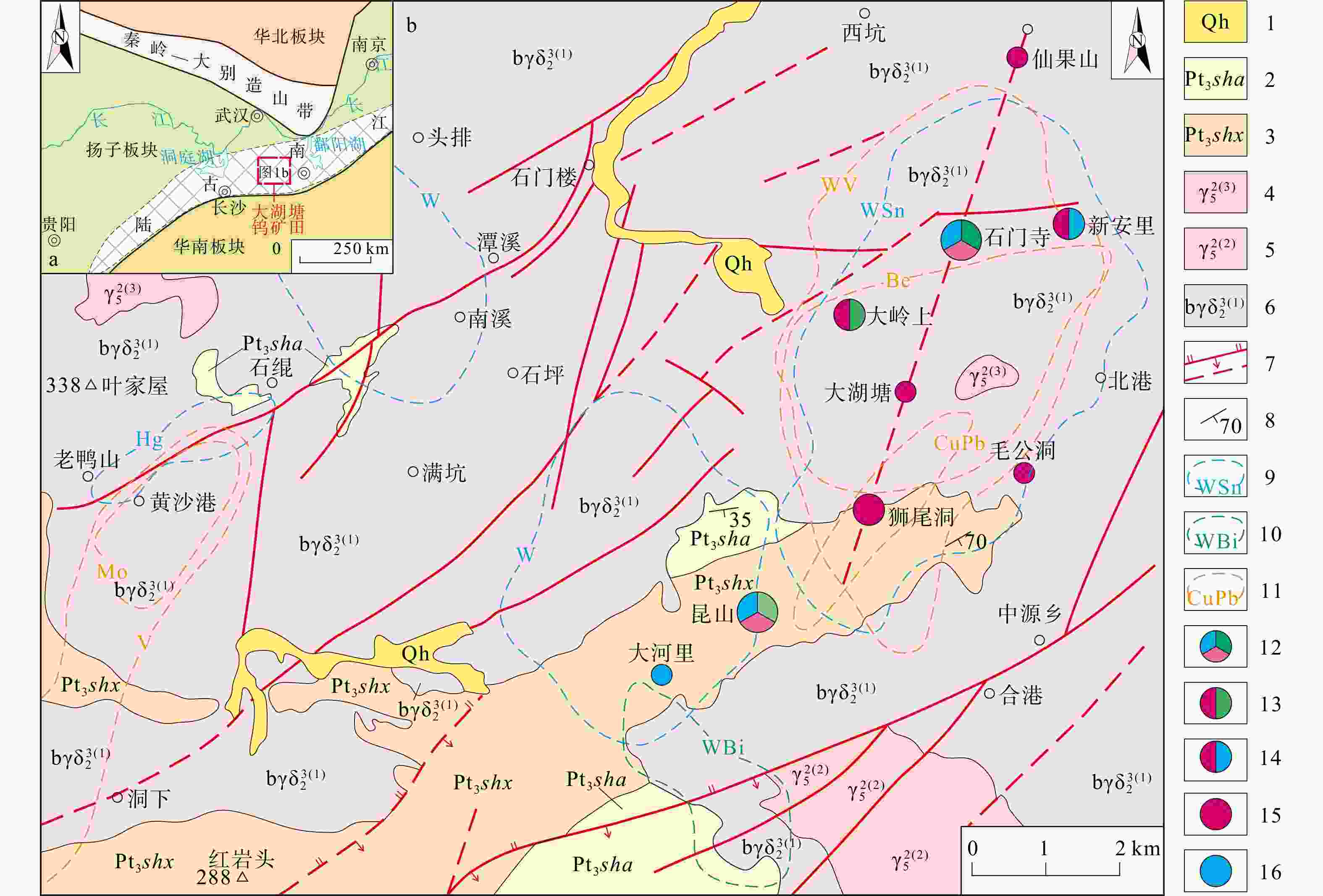
 下载:
下载:
